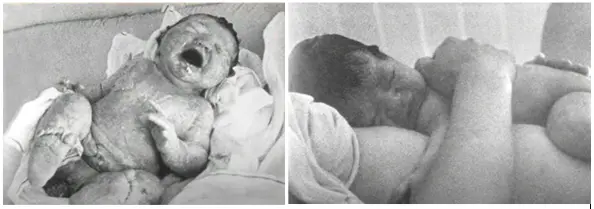Primal therapy is a form of psychotherapy that was developed by American psychologist Arthur Janov in the 1960s. It is based on the idea that many of our psychological issues and emotional problems stem from unresolved traumas that we experienced in early childhood. The therapy aims to help individuals access and confront these repressed emotions and memories in order to work through them and heal. One of its core tenets is the importance of the relationship between a mother and her infant for the child’s emotional development. Two key teachings of primal therapy I believe are particularly noteworthy. I had not considered either of these prior to learning about primal therapy.
Firstly, cutting the umbilical cord too early, before the infant has had a chance to fully bond with their mother, is believed to have long-term negative effects on the child’s emotional well-being. This is because the bond between mother and child is established through a process of mutual dependency and attachment during the first few months of life.
Secondly, primal therapy highlights the concerning societal trend of leaving infants or young children alone in a room to cry for prolonged periods, or leaving them alone in a room at all. Such circumstances are highlighted as potentially harmful to a child’s emotional well-being, as they may cause the child to feel abandoned and alone.

Image left: showing child birth as we are accustomed to seeing it – what Janov believes and appears to be a traumatised baby.
Image right: showing child birth where the umbilical cord is yet to be cut and the mother and child are in a skin-on-skin embrace.
According to Janov, the bond between mother and child is established through a process of mutual dependency and attachment. During the first few months of life, the infant is completely dependent on their mother for survival and comfort. Through this dependency, the child develops a sense of trust in their mother and in the world around them. Janov believed that cutting the umbilical cord too early disrupts this process of attachment and can lead to emotional disturbances later in life. He argued that when the umbilical cord is cut prematurely, the infant is abruptly separated from their mother and forced to confront the harsh realities of the world on their own. This can cause the child to feel abandoned, helpless, and alone, and can lead to a range of emotional problems in later life.
Primal therapy seeks to address these emotional issues by helping individuals to re-experience and work through their early traumas. Through a combination of talk therapy, guided imagery, and other techniques, primal therapy aims to help individuals access the deep-seated emotions and memories that may be causing them distress. By confronting these traumas and working through them, individuals can begin to heal and move towards greater emotional well-being.
While primal therapy has been controversial over the years, many proponents believe that it can be a powerful tool for healing emotional wounds. Whether or not you agree with Janov’s theories and treatments, there is no denying that early childhood experiences can have a profound impact on our emotional health and well-being. While primal therapy is not without controversy, many individuals have found it to be a powerful tool for healing emotional wounds and moving towards greater emotional well-being. If you would like to know more about primal therapy, there is a research and training centre located in Venice, California – Primal Treatment, Training & Research Center.

Nils Strohbeck
Connect
A Perfect Coup: Pharmaceutical Industry’s Hold on Healthcare
A dive into industry's extensive influence
Lead and the Fall of the Roman Empire: Welcome the ‘Aluminium Age’
How Aluminium is Affecting Our Health









